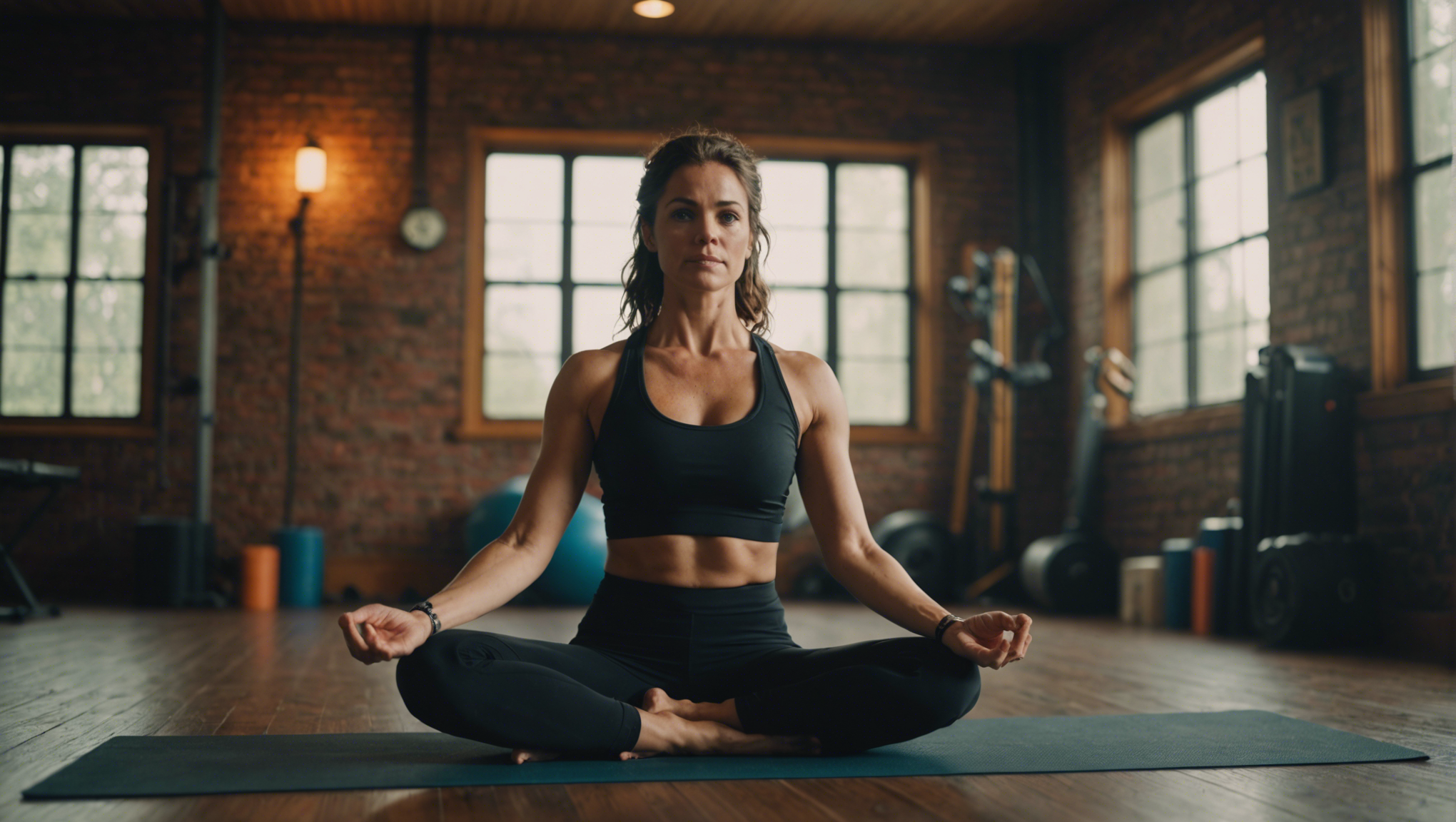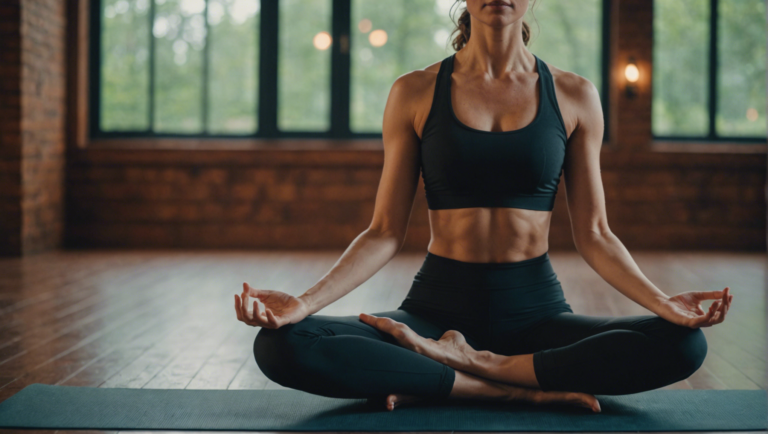Does Yoga Qualify As Strength Training? Unveiling The Truth
Unveiling the Truth: Does Yoga Qualify as Strength Training?
The intersection of yoga and strength training has become a topic of much interest in the fitness community. With the growing trend of incorporating holistic practices into traditional workout routines, many are questioning whether yoga alone can serve as a comprehensive method for building strength. This exploration seeks to provide clarity on this subject, delving into the nuances of yoga as a practice and its potential role within the spectrum of strength training disciplines.
The Nature of Yoga and Its Role in Physical Fitness
Yoga, an ancient practice with roots stretching back thousands of years, encompasses a range of physical, mental, and spiritual disciplines. Originating in India, it has evolved into various styles, each focusing on different aspects of health and well-being. At its core, yoga emphasizes posture (asanas), breathing techniques (pranayama), and meditation (dhyana), targeting flexibility, mental clarity, and stress reduction.
From a fitness perspective, yoga challenges the body through static holds and dynamic sequences, engaging muscle groups in a unique manner compared to traditional strength training methods. This engagement primarily revolves around bodyweight exercises, promoting muscular endurance and stability.
Examining Yoga’s Capacity for Muscle Strengthening
Understanding how yoga contributes to muscle strengthening requires an examination of the physiological aspects of strength development. Strength training, traditionally understood, involves the use of resistance to induce muscular contraction, leading to growth and increased power. This resistance can come in many forms, including free weights, machines, or an individual’s own body weight.
Yoga’s approach to strength lies in isometric contractions, where the muscle length does not change significantly during the exercise, and eccentric movements, which involve lengthening of the muscle under tension. Such exercises can indeed contribute to muscular strength, particularly in terms of endurance and functional movement patterns.
The Diversity of Yoga Practices and Their Impact on Strength
Different styles of yoga offer various levels of intensity and emphasis on strength-building aspects. For example:
- Ashtanga Yoga and Power Yoga: These are more dynamic and physically demanding, focusing on a series of poses that build heat and physical strength.
- Iyengar Yoga: While less aerobic, it involves holding poses for longer periods, which can significantly challenge muscular endurance and control.
- Yin Yoga: Though primarily targeting flexibility and relaxation, certain poses can also aid in strengthening connective tissues and joints.
This diversity means that yoga’s contribution to strength training can be adjusted and tailored to an individual’s needs, complementing traditional regimes with increased flexibility and muscle control.
Balancing Yoga with Traditional Strength Training
For those seeking the benefits of muscle building and functional strength, yoga can be a valuable component of a balanced fitness regimen. While it may not replace traditional strength training, especially for those looking to significantly increase muscle mass or achieve peak physical conditioning, yoga offers a holistic approach to fitness that enhances range of motion, body awareness, and mental discipline.
Integrating yoga into a strength training routine can provide recovery benefits, reduce the risk of injury, and improve the quality of movements through better flexibility and core strength. This cross-training approach ensures a comprehensive fitness strategy, addressing muscular strength from multiple angles.
Navigating Your Fitness Journey with Yoga
Deciding on the role of yoga in one’s fitness journey requires considering individual goals, physical condition, and personal preference. For those aiming for moderate strength gains, increased flexibility, and mental clarity, yoga can serve as a substantial part of their regime. Meanwhile, athletes or fitness enthusiasts targeting specific strength goals may find yoga most beneficial as a complementary practice.
The integration of yoga into fitness routines exemplifies the evolving understanding of health and well-being, recognizing the importance of a balanced approach to physical exercise that nurtures not only the body but also the mind and spirit. By examining and appreciating the depth of yoga’s contribution to strength training, individuals can make informed decisions that align with their health objectives and lifestyle preferences, paving the way for a holistic journey towards wellness.
Types of Yoga and Their Impact on Muscular Strength
Yoga, an ancient practice with its roots steeped in millennia of tradition, has evolved to meet the fitness and wellness needs of today’s society. Often perceived as a serene and meditative practice, yoga also offers a wide array of styles that can significantly impact muscular strength. This exploration into different yoga practices and their effects on building muscular strength reveals the multifaceted nature of yoga, far beyond its stereotype as merely a form of relaxation or flexibility training.
Unveiling the Power of Ashtanga Yoga
Ashtanga Yoga, known for its dynamic flow and physically demanding postures, stands out as a formidable method for enhancing muscular strength. This style follows a specific sequence of poses, each linked with breathwork, ensuring a rigorous workout that targets various muscle groups. As practitioners move swiftly from one posture to another, they engage their core, arms, legs, and back, offering a comprehensive muscle-strengthening session. The repetitive nature of Ashtanga Yoga not only builds muscle but also improves muscle memory, enhancing physical endurance over time.
The Strength-Building Capacities of Power Yoga
Power Yoga, a derivative of Ashtanga Yoga, is tailored more towards the fitness enthusiast, with its high-intensity approach focusing significantly on building strength and stamina. This yoga style incorporates a variety of poses that engage and strengthen the core, arms, legs, and glutes. Not adhering to a fixed set of sequences, Power Yoga classes can vary, but all aim to push the body’s limits, fostering muscle growth and endurance. The inclusion of weights or resistance bands in some Power Yoga sessions further amplifies its strength-building potential, making it a popular choice for those looking to mix yoga with conventional strength training techniques.
Vinyasa Yoga: A Fluid Approach to Strength
Vinyasa Yoga, characterized by its fluid, movement-intensive sequences, offers a unique approach to building muscular strength. Unlike the static holds of other yoga styles, Vinyasa focuses on the transition between poses, maintaining a continuous flow that demands sustained muscle engagement. This constant movement challenges the body’s stabilizing muscles, crucial for building core strength and improving overall muscle tone. Moreover, the adaptability of Vinyasa Yoga allows practitioners to incorporate more strenuous poses as they progress, facilitating continued muscular development and endurance.
Embracing Slow Strength in Yin Yoga
While Yin Yoga is often associated with deep stretching and meditative focus, it also plays a subtle yet effective role in enhancing muscular strength. By holding poses for extended periods, typically three to five minutes, Yin targets the body’s connective tissues, such as ligaments and tendons, along with activating deeper muscle fibers that are often overlooked in traditional strength training. This practice promotes increased circulation to joints and improves flexibility, which are essential components in building a balanced, strong muscular framework. Though less intense, Yin Yoga’s approach fosters endurance and resilience in both muscles and mind.
Kundalini Yoga: An Energetic Approach to Muscle Tone
Kundalini Yoga combines spiritual and physical practices, featuring an array of dynamic exercises known as Kriyas alongside meditative techniques and chanting. The physical aspects of Kundalini Yoga often involve repetitive, high-energy movements that stimulate the core and lower body muscles, contributing to improved muscle tone and strength. Additionally, the focus on breathwork and energy flow enhances muscular efficiency and endurance, offering a unique blend of spiritual and physical fortification.
Yoga’s diversity offers numerous pathways to improving muscular strength, each with its distinctive focus and techniques. From the intense sequences of Ashtanga and Power Yoga to the more meditative and slow-paced approaches of Yin and Kundalini Yoga, practitioners have a wealth of options to explore that go well beyond traditional strength training methods. The incorporation of these varied yoga practices into a regular fitness regime can lead to profound improvements in muscular strength, endurance, and overall physical health, providing a holistic approach to personal wellness that nourishes both body and soul.
Comparing Yoga to Traditional Strength Training Methods
Yoga Vs. Traditional Strength Training: A Detailed Comparison
When it comes to sculpting our bodies, gaining strength, and enhancing our overall fitness, the debate between yoga and traditional strength training methods often surfaces. Both have their unique advantages, methodologies, and outcomes that cater to different fitness goals and preferences. As we delve into the intricate aspects of these distinct practices, it becomes evident that choosing one over the other depends on the individual’s objectives, lifestyle, and body needs.
Understanding Yoga and Its Holistic Approach
Yoga, with its roots embedded in ancient India, is a comprehensive practice that combines physical postures (asanas), breath control (pranayama), meditation, and a disciplined lifestyle. Unlike conventional gym routines, yoga emphasizes balance, flexibility, mental clarity, and the synchronization of breath with movement. This practice offers a plethora of styles ranging from the gentle and restorative to the intensely physical and athletic.
The strength developed through yoga is unique in its approach, focusing on bodyweight exercises and holding postures for extended periods. This not only enhances muscle endurance but also improves joint stability, flexibility, and body awareness. Yoga’s holistic approach encourages mindfulness and a deeper connection with one’s body, making it a transformative journey both physically and spiritually.
The Dynamics of Traditional Strength Training
Traditional strength training, often synonymous with weight lifting or resistance training, involves the use of external weights, machines, or one’s own body weight to create resistance. The primary goal here is to build muscle mass, strength, and endurance by repeatedly challenging the muscles through a variety of exercises targeting specific muscle groups.
This method follows the principle of progressive overload, where the muscles are gradually subjected to increased weight or resistance, leading to improvements in muscle size and strength. Traditional strength training is highly customizable, with routines that can be tailored to suit everyone from beginners to professional athletes.
How Yoga and Traditional Strength Training Complement Each Other
Though seemingly distinct, yoga and traditional strength training are not mutually exclusive. elements from both can lead to a well-rounded fitness regimen. While yoga improves flexibility, posture, and mental well-being, strength training accelerates muscle building, metabolic rate, and bone density.
For individuals seeking balance in their workout routine, blending the mindfulness and flexibility of yoga with the muscle-building prowess of traditional strength training could be the key to achieving holistic health and fitness.
Evaluating the Benefits for Different Fitness Goals
The choice between yoga and traditional strength training largely revolves around personal fitness goals. If improving flexibility, reducing stress, and cultivating a mind-body connection are priorities, yoga emerges as the clear winner. Conversely, for goals centered around building muscle mass, increasing raw strength, or enhancing athletic performance, traditional strength training holds the advantage.
However, it’s crucial to recognize that these practices are not mutually exclusive. Many athletes and fitness enthusiasts find value in incorporating both into their routines, leveraging the strength and flexibility gains from yoga to enhance their performance and resilience in weight training, and vice versa.
Making an Informed Decision for Your Fitness Journey
Embarking on a fitness journey is a personal endeavor, and the choice between yoga and traditional strength training should align with one’s health objectives, lifestyle, and personal preferences. Understanding the unique benefits of each can guide individuals toward a regimen that not only meets their physical aspirations but also enriches their mental and emotional well-being.
Whether you gravitate towards the serene challenge of yoga or the rigorous discipline of traditional strength training, the ultimate goal should be a balanced regimen that fosters physical vitality, mental clarity, and overall health. Listening to your body and making informed choices will pave the way for a fulfilling fitness journey that harmonizes the body, mind, and spirit.
The Science Behind Yoga and Muscle Building
Unveiling the Truth About Yoga as a Strength Training Endeavor
Yoga, an ancient practice that has traversed centuries and cultures, has long been celebrated for its immense benefits on the mind and body. As it becomes increasingly integrated into modern wellness and fitness routines, one question frequently arises: Can yoga truly serve as an effective means of strength training? This discourse aims to unpack the science behind yoga and its capacity to build muscle, bolstering the understanding of its role in a comprehensive fitness regimen.
The Intersection of Yoga and Muscle Building
Yoga’s essence lies in its diverse range of poses (asanas) and sequences, which are designed to improve flexibility, balance, and, crucially, strength. Unlike traditional strength training that relies on external weights or equipment, yoga uses the body’s own weight to create resistance. This resistance is pivotal in stimulating muscle growth and development.
Each pose and transition in yoga demands a significant level of muscular engagement, from core stabilization to limb extension. This constant tension not only enhances muscular endurance but also contributes to muscle hypertrophy over time. Consequently, the practice of yoga can indeed lead to increases in muscle mass and strength, especially when practiced consistently and with increasing difficulty.
The Role of Slow, Controlled Movements
One of the fundamental aspects of yoga that contributes to its efficacy as a muscle-building practice is the emphasis on slow, controlled movements. This deliberate pacing increases the time muscles remain under tension, a crucial factor in muscle strength and endurance training. Moreover, the focus on alignment and posture in yoga ensures that muscles are engaged properly, reducing the risk of injury and ensuring that the intended muscle groups are effectively worked.
The Science of Stretching and Strength
Contrary to the notion that yoga is merely a passive practice focused on stretching, scientific research supports the idea that yoga’s dynamic stretches and poses significantly contribute to muscular strength. The act of stretching itself, particularly when combined with the isometric resistance inherent in holding yoga poses, can lead to improved muscular strength and flexibility. This dual impact enhances overall athletic performance and functional fitness, serving as a testament to yoga’s holistic approach to strength and health.
Real-World Evidence and Expert Opinions
Health and fitness experts have increasingly acknowledged yoga’s potential in supporting strength training objectives. This acknowledgment is rooted not just in anecdotal evidence but also in empirical research studies that have explored the impact of regular yoga practice on muscle strength, endurance, and overall physical fitness. Such studies often highlight improvements in upper body strength, core stability, and lower body power among regular yoga practitioners.
Crafting a Balanced and Integrated Approach
For individuals looking to maximize their strength training results, integrating yoga into their fitness regimen could be the key to unlocking enhanced flexibility, reduced injury risk, and an overall more balanced and effective workout program. While yoga might not replace traditional strength training entirely, it serves as a compelling complement, enriching the fitness journey with its unique blend of mental and physical disciplines.
Yoga’s standing as a viable strength training alternative or supplement is increasingly supported by both scientific inquiry and personal testimonials. It champions the idea that strength isn’t solely measured by muscle mass or lifting prowess but also by the ability to control and master one’s own body weight and movement. As such, yoga invites us to redefine our notions of strength and fitness, spotlighting the profound capabilities of our bodies when engaged mindfully and purposefully.
In essence, yoga transcends its spiritual roots to offer substantial gains in muscle strength, endurance, and overall physical well-being. Its practice serves as a potent testament to the body’s adaptability and potential, encouraging a more inclusive and holistic approach to strength training that benefits both the body and the mind.
Integrating Yoga Into a Comprehensive Strength Training Regimen
The Synergy Between Yoga and Strength Training
Yoga, an ancient practice with its roots nestled deep within the realms of spirituality and physical well-being, has long been heralded for its numerous health benefits. However, when juxtaposed with the modern principles of strength training, yoga transforms into a powerful ally, enhancing not only the strength and endurance of practitioners but also integrating a comprehensive dimension of flexibility, balance, and core stability into their regimen.
Understanding the Multifaceted Benefits of Yoga
Yoga is not merely a series of postures and breaths; it is a holistic discipline that intertwines the physical with the mental. Each pose is designed to target specific muscle groups, while the breathing techniques foster mental clarity and concentration. For those engaged in strength training, incorporating yoga can lead to remarkable improvements in flexibility, which in turn can help reduce the risk of injuries by making the muscles and joints more resilient.
The Balance of Flexibility and Strength
One common misconception is that strength training may lead to muscle stiffness, and flexibility work, like yoga, might potentially weaken muscle strength. However, this couldn’t be further from the truth. yoga into a strength training program creates a balanced workout routine where the benefits of both flexibility and strength are harnessed. Poses like the Warrior series, Chaturanga, and Tree pose build muscle endurance, core strength, and balance — essential components for anyone looking to enhance their physical fitness.
Enhancing Recovery Through Yoga
Recovery plays a critical role in any strength training regimen. It’s during this time that muscles repair and grow stronger. Yoga can serve as an active recovery tool, offering a gentle means to stimulate blood flow to tired muscles, facilitating quicker recovery, and, importantly, minimizing the onset of muscle soreness. Practices like Yin Yoga or Restorative Yoga are perfect on rest days, promoting relaxation and flexibility without overstraining the body.
A Guide to Integrating Yoga
To effectively meld yoga with strength training, it’s essential to listen to your body and understand its needs. On heavy lifting days, opting for gentle yoga sessions can help in unwinding and stretching the muscles. Conversely, on lighter days or rest days, more dynamic yoga practices like Ashtanga or Vinyasa can maintain the momentum of physical exertion without overtaxing the body.
The Psychological Edge
Beyond the physical, yoga offers a mental toughness and focus that is beneficial in any sport or physical activity. The meditative aspects help in cultivating a stronger mind-body connection, which can significantly impact motivation and performance. By practicing mindfulness and concentration through yoga, individuals are better equipped to handle the mental challenges posed by rigorous strength training routines.
Customizing Your Yoga Practice for Strength Training
To garner the maximum benefits, it’s advisable to tailor your yoga practice to complement your strength training goals. For instance, focusing on poses that strengthen the core and improve balance directly contributes to a more stable and powerful base for lifting. Similarly, targeting flexibility in the hips and shoulders can enhance the range of motion, allowing for more effective execution of strength training exercises.
Integrating yoga into a comprehensive strength training regimen offers a holistic approach to fitness that nurtures not only physical strength but also flexibility, balance, and mental well-being. By merging the agility and mindfulness cultivated through yoga with the robustness and vigor of strength training, practitioners can achieve a more balanced and sustainable fitness journey. This fusion not only elevates the overall quality of workouts but also enriches the practitioner’s lifestyle, paving the way for a healthier, more vibrant existence.
Conclusion
Embarking on the journey to unravel whether yoga can stand tall amongst traditional strength training methods, we’ve carefully dissected the essence, variations, and scientific backing of yoga in enhancing muscular strength. Our exploration has not only highlighted the diverse spectrum of yoga practices but also placed these ancient techniques under the scrutinizing lens of modern science to ascertain their efficacy in muscle building.
Yoga, with its rich tapestry of styles, from the gentle waves of Hatha to the vigorous surge of Ashtanga, offers more than just a serene escape from the tumult of daily life. It has emerged as a potent ally in the quest for physical strength, challenging the preconceived boundaries between traditional strength training and flexibility-focused practices. Each style, with its unique intensity and focus, contributes varying degrees of benefit to the muscular system, underscoring yoga’s versatility as a physical regime. Whether aiming for improved muscle tone, endurance, or strength, yoga presents a repertoire of poses and sequences tailored to meet these objectives, thereby validating its position as a form of strength training.
Contrasting yoga with conventional strength training methods illuminates a foundational difference; while the latter often relies on external weights or resistance machines to build muscle, yoga employs the weight of one’s own body to achieve similar results. This intrinsic approach to strength training underscores the holistic essence of yoga, encapsulating the synthesis of mind, body, and spirit. The scientific community, too, has lent its voice to this dialogue, providing empirical evidence that supports yoga’s efficacy in augmenting muscular strength, improving balance, and enhancing flexibility. Studies have illuminated how consistent yoga practice contributes to muscle hypertrophy, akin to the results obtained from weight-lifting regimes, albeit often over a more extended period and with a broader emphasis on overall well-being.
The integration of yoga into a comprehensive strength training regimen offers a harmonious balance, marrying the dynamic power of resistance training with the static strength and flexibility inherent in yoga practice. This fusion not only optimizes physical health by providing a well-rounded fitness routine but also nurtures mental resilience and emotional equilibrium. The symbiotic relationship between mind and muscle forged through yoga practice amplifies the benefits obtained from traditional strength training methods, paving the way for a more holistic approach to muscle building and physical fitness.
As we’ve traversed through the intricate landscapes of yoga and strength training, a clear picture emerges: yoga indeed qualifies as a form of strength training, yet it transcends conventional definitions and expectations. By embracing the multifaceted contributions of yoga to physical strength, flexibility, and mental well-being, individuals can unlock a comprehensive paradigm of health and fitness that resonates with modern demands for a balanced lifestyle.
The journey toward understanding yoga’s place within the realm of strength training opens up new avenues for personal growth and fitness. As practitioners of health and wellness, the invitation stands to redefine strength in broader, more inclusive terms, recognizing the integral role of yoga in cultivating not only physical prowess but also an unwavering strength of spirit.
In light of this exploration, yoga’s rightful claim to the strength training domain is unequivocally affirmed, yet it also challenges us to expand our perceptions of what it means to be truly strong. The convergence of yoga and traditional strength training methods heralds a comprehensive approach to fitness that celebrates the diversity of pathways leading to physical robustness, holistic health, and the unwavering strength of the human spirit.



